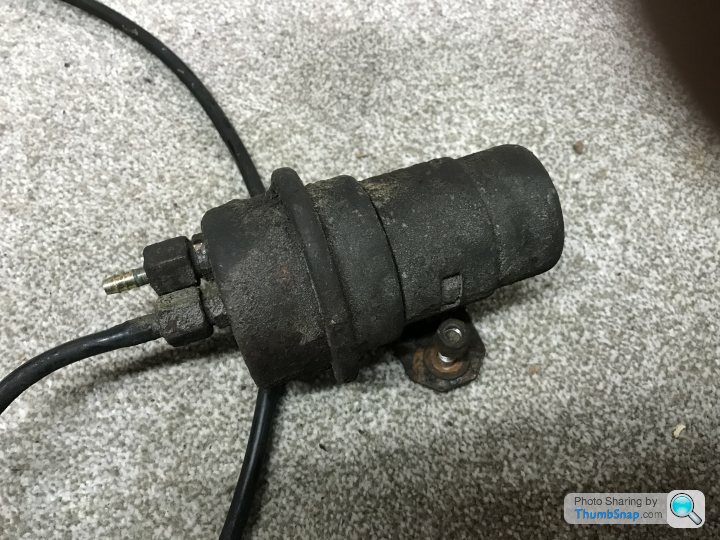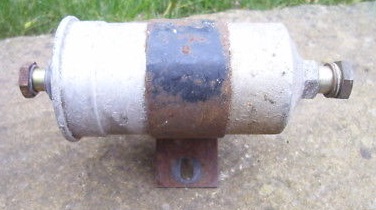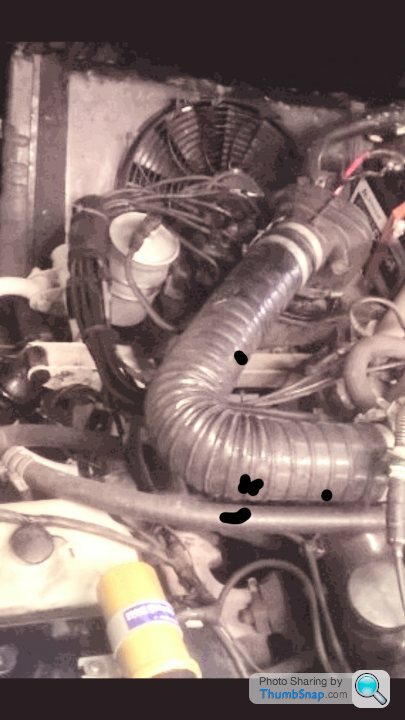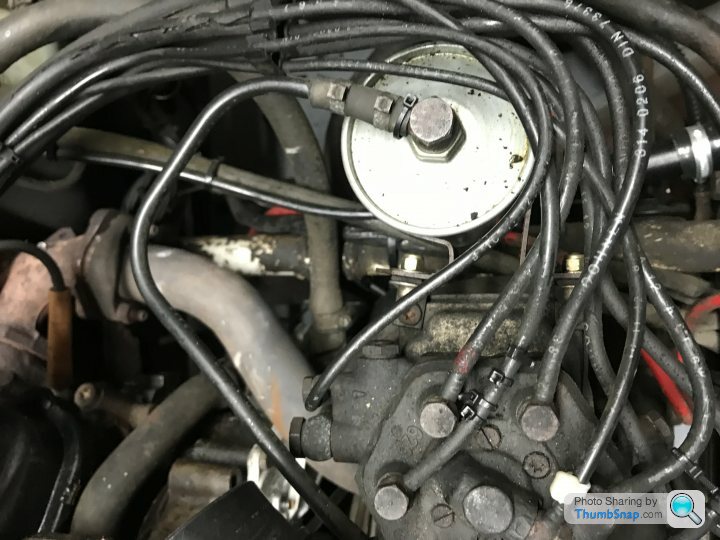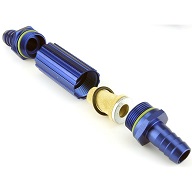S1 fuel filter setup
Discussion
AlfaSpider said:
this filter was installed after the fuel pump
That's the accumulator.There shouldn't be a filter on the return.
I would suggest you stick with the correct fuel filter rather than any generic, one filter fits all thingy. Filter is under pressure, needs to be right.
A bit of light reading for you........ Bosch K-Jetronic
The item in the photo is the high pressure fuel filter just before the injector head. It is a standard and readily available item. The fuel feed from the pump should come to the banjo underneath. You may well find that the unit will not reseal after removal. Best to replace it anyway but at both top and bottom banjo's (which are different sizes so there should be no mix up) there are copper seal washers. DO NOT USE FABRIC OR RUBBER! There washers can be annealed to restore them, heat to cherry red in a gas flame then plunge into cold water. They should come out pink, the copper is now softened and will seal properly.
Take great care if you remove this unit after running the car. The accumulator (your first picture) is there to ensure pressure at the injector is constant and maintained, that pressure will last for a very long time after stopping the car. Unscrew a banjo with pressure still there will squirt pressure everywhere, not good it it hits heat or your eyes!!
Returning to fuel filters. In your car there will have been a nylon filter in the swirl pot, the projection at the bottom of your fuel tank. If the tank is original that filter is almost certainly shot, possibly partly blocked and impeding flow as well as letting c**p through. If you can free the access to the swirl pot, get the filter out and clean that area. It will also give you an idea how much muck/rust there is. If the tank is bad send it to Hartlepool Radiator to restore, the system they use is the best we know of.
It is better to install and in line filter between tank and pump, these pumps are pretty vulnerable if much gets inside. Remember however it is a big 5/8 bore fuel line pre pump so an ordinary plastic cheapo in line will not do. There are big bore ones available for the likes of Car Builder Solutions or Demon Tweeks. I went mad and fitted a Sytec filter with a removable cartridge, which has proved a good investment, it is pretty easy to get a little water in when filling and the filter has held it back as well as a little muck, possibly from a fuel filler?
Take great care if you remove this unit after running the car. The accumulator (your first picture) is there to ensure pressure at the injector is constant and maintained, that pressure will last for a very long time after stopping the car. Unscrew a banjo with pressure still there will squirt pressure everywhere, not good it it hits heat or your eyes!!
Returning to fuel filters. In your car there will have been a nylon filter in the swirl pot, the projection at the bottom of your fuel tank. If the tank is original that filter is almost certainly shot, possibly partly blocked and impeding flow as well as letting c**p through. If you can free the access to the swirl pot, get the filter out and clean that area. It will also give you an idea how much muck/rust there is. If the tank is bad send it to Hartlepool Radiator to restore, the system they use is the best we know of.
It is better to install and in line filter between tank and pump, these pumps are pretty vulnerable if much gets inside. Remember however it is a big 5/8 bore fuel line pre pump so an ordinary plastic cheapo in line will not do. There are big bore ones available for the likes of Car Builder Solutions or Demon Tweeks. I went mad and fitted a Sytec filter with a removable cartridge, which has proved a good investment, it is pretty easy to get a little water in when filling and the filter has held it back as well as a little muck, possibly from a fuel filler?
The fuel tank and internal filter are thankfully in good condition, I was considering fitting one of these before the pump.
https://www.carbuildersolutions.com/uk/15mm-washab...
I was planning on fitting one and checking the flow rate before and after just to make sure it’s ok. The sytec filter looks good but unfortunately out of my budget!
https://www.carbuildersolutions.com/uk/15mm-washab...
I was planning on fitting one and checking the flow rate before and after just to make sure it’s ok. The sytec filter looks good but unfortunately out of my budget!
Stop watch and a bucket!
Measure the flow (place the bucket, or in my case petrol can) at the regulator OUTLET so you're measuring the pump output at reg. pressure rather than open.
But you knew that already!
The CBS filter has a sintered metal cartridge which will easily clog-up at the least amount of crud. I replaced mine with a unit I soldered up from plumbing parts which contains only a mesh screen similar in principle to the original thimble filter. I can do a sketch if anyone's interested.
Measure the flow (place the bucket, or in my case petrol can) at the regulator OUTLET so you're measuring the pump output at reg. pressure rather than open.
But you knew that already!
The CBS filter has a sintered metal cartridge which will easily clog-up at the least amount of crud. I replaced mine with a unit I soldered up from plumbing parts which contains only a mesh screen similar in principle to the original thimble filter. I can do a sketch if anyone's interested.
'The CBS filter has a sintered metal cartridge which will easily clog-up at the least amount of crud. I replaced mine with a unit I soldered up from plumbing parts which contains only a mesh screen similar in principle to the original thimble filter.'
Dont really want to argue with you but I will
If the filter shown blocks up with crud and yours doesn't, does that mean yours is ineffective?!
The original filters were quite poor anyway but they were cylindrical so the total filter area was quite reasonable. The type shown is also cylindrical but a bit cleverer in where it stores the crud. It is similar in principle to the Sytec one which is used at the top end of the market. It is designed to allow full flow until the annular volume outside the cartridge is full. If that ever happened the tank would be pretty bad, and without a filter the pump would have been wrecked by then anyway. My Sytec has a removable filter, that bit costs peanuts, it gets changed at routine services, it has always found something.
Dont really want to argue with you but I will

If the filter shown blocks up with crud and yours doesn't, does that mean yours is ineffective?!

The original filters were quite poor anyway but they were cylindrical so the total filter area was quite reasonable. The type shown is also cylindrical but a bit cleverer in where it stores the crud. It is similar in principle to the Sytec one which is used at the top end of the market. It is designed to allow full flow until the annular volume outside the cartridge is full. If that ever happened the tank would be pretty bad, and without a filter the pump would have been wrecked by then anyway. My Sytec has a removable filter, that bit costs peanuts, it gets changed at routine services, it has always found something.
greymrj said:
Dont really want to argue with you but I will
Is this the five-minute argument or the full half-hour?
The original in-tank screen filter works quite well, but has two major defects:
The tank has to be removed to get at it and
It's made of unobtainium.
Looked at through a magnifying glass, it seems to have an aperture size of about 0.2mm, so I looked for a copper mesh of about that size (it's RF shielding mesh). That size was clearly deemed acceptable to protect the pump from large particles, by TVR's designers.
Are the Sytec filters 8/35 micron? I don't know what the filtration size of the CBS filter is but I assume it's similar. I do know that it blocks easily with 'sludge'-sized particles, causing the pump to cavitate. That's what happened when I DID have a corroded tank, before Hartlepool Radiator Company fixed it for me.
I suspect that cavitation and dry bearings (due to a blocked inlet) is more of a danger to the pump than a blocked outlet filter, though I'm often wrong..... But I changed the pump anyway.
No, I don't have a problem at present, but I will check the filter next time the tank is empty. And I may fit a shut-off valve so I can check it more often!
So IMHO it's better to have a coarse 'filter' (say, 200 micron) before the pump, and rely on the HP filter (also a service item of course) to filter out fines down to 10 or even 2 microns.
It's good to talk!
Gassing Station | S Series | Top of Page | What's New | My Stuff




